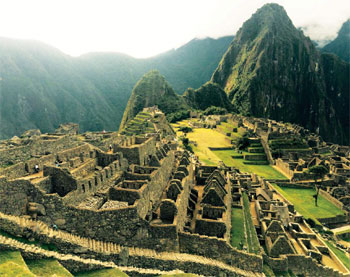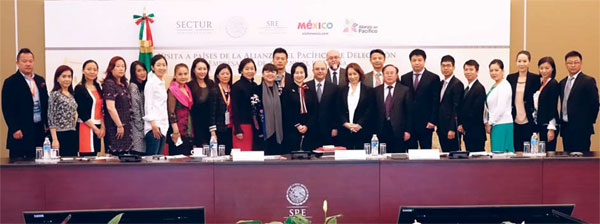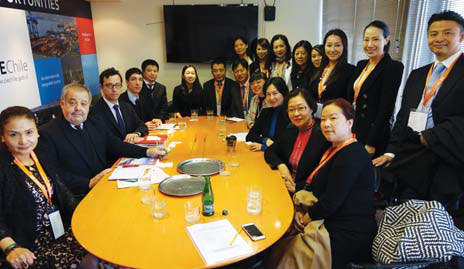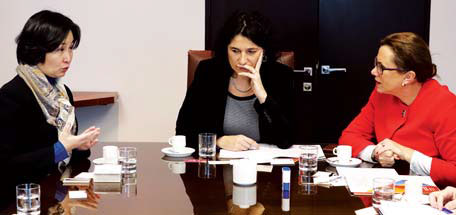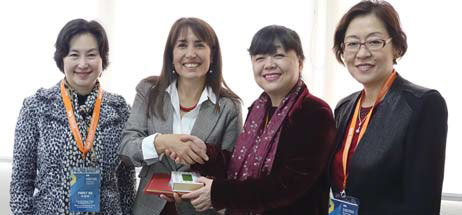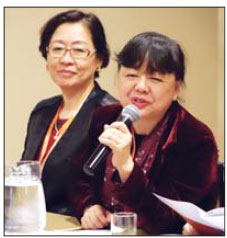Going the distance
Inspired by China's Belt and Road Initiative, the Global Tourism Economy Forum embarked on a Pacific Alliance mission, starting a virtuous cycle of events to create momentum in driving exchange, multilateral cooperation and economic growth in global tourism, Andrea Deng reports.
During his four-nation Latin American tour in late May, Premier Li Keqiang signed a number of economic deals and promoted bilateral cultural cooperation that will strengthen ties between China and the region.
The milestone trip will inspire connectivity in trade and between people.
Li's trip was part of China's effort to drive its Belt and Road Initiative, a strategy inspired by the historical Silk Road, and adapted to deepening economic cooperation between countries and regions worldwide.
A week after Li's trip in June, Pansy Ho, vice-chairperson and secretary general of Macao-based Global Tourism Economy Forum (GTEF), led a 30-member strong delegation to the Pacific Alliance (PA) on a mission to kick start a virtuous cycle of GTEF organized events to create momentum in driving exchange, multilateral cooperation and economic growth in global tourism.
This was a timely visit as the PA nations are not yet major tourist destinations for Chinese travelers. Geographically, Latin America, especially the PA countries - Mexico, Colombia, Peru and Chile - is located furthest from China. Yet they boast a wealth of tourist resources and offer huge potential for attracting travelers from China and other Asian nations.
The Pacific Alliance mission
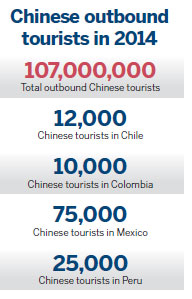
The China National Tourism Administration (CNTA) reports that 107 million Chinese tourists traveled overseas in 2014, a 19.49-percent increase from 2013. Destinations in Asia remained the most popular, at almost 80 percent of the total, followed by Europe, Africa and the Americas.
However, the number of tourists visiting the PA countries only accounts for a tiny portion of the huge market in outbound Chinese tourism. There are not even any direct flights to the region from Hong Kong at present and a flight from the SAR, via transit, can take up to 30 hours. Moreover, current visa requirements in the region have dampened the interest of Chinese tourists.
Yet, with their ancient civilizations and timeless cultural heritage the PA countries have exceptional potential for tourism, which makes them worthy of the attention and interest of Chinese tourists.
"This is the right time for us to visit (the PA countries) because, while the Chinese mainland has adopted policies and clinched deals with Latin America to strengthen economic ties, outbound Chinese tourism continues to grow," said Ho.
Ho stressed that the benefits of tourism would be felt far beyond those businesses directly involved; extending to travel agencies, airlines and the entire hospitality supply chain.
A wider benefit of booming tourism would be its benefits to countries and regions through the construction of improved infrastructure, real-estate development and job opportunities, along with a boost to the entire global economy.
Ho noted that although it would take time to implement simplified visa procedures for Chinese visitors to the region, businesses from both sides should start communicating to strengthen ties and build mutual understanding.
High caliber delegates
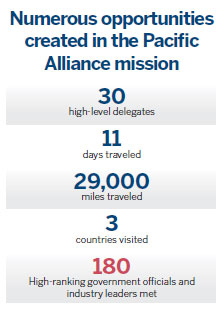
Co-organized by the China Chamber of Tourism and the China Women's Chamber of Commerce, the PA mission comprised top executives of leading tourism sector players from the mainland, Hong Kong and Macao.
Among the delegates, Liu Ting, participated in her capacity as chairperson of China Women's Chamber of Commerce, an organization of which 30 percent of its members hold assets valued in the hundreds of millions of yuan.
Liu is also chairperson and president of Asia Link Group, an investment corporation and consultancy with a portfolio spanning sectors including aviation, high-tech, bioengineering, marine equipment. Asia Link Group is also the major shareholder of Sungari International Auction House - one of China's top five auction firms.
Some of the high caliber delegates included Zhang Shanjiu, vice-chairman of Karst Cave Professional Committee of China Chamber of Tourism, and president of NASDAQ-listed Shandong Longon Tourism Group; Nimazhaxi, chairman of Tibet Chamber of Tourism, and chairman of Tibet Hongji Group and Dina Luo Jing, director in the international business department of Macrolink Group - one of China's top 50 privately owned enterprises; an investment corporation with holdings in a wide spectrum of industries including real estate, petroleum and mining, to name a few.
Li Xiaomei, deputy general manager of Yunnan Mekong Group said, "This trip is rather high level in my experience of attending quite a few other business trips, because many of the delegates are leaders in our trade and because the people we're meeting locally in the PA countries were high-ranking government officials or local industry leaders. So I do feel that the GTEF has set the standard of the trip pretty high."
Although delegates were all tourism sector leaders, some had not met before. The PA mission not only brought them together physically for the journey, but also provided ample opportunity for them to share ideas.
Meeting the elites
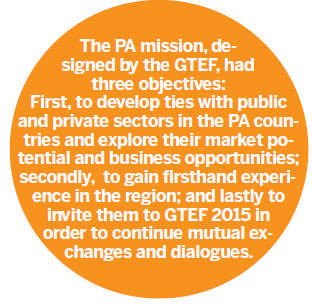
During the 11-day mission, the delegation met with over 180 heavyweights of the tourism sector, including government foreign affairs and tourism ministers at the highest levels and tourism industry leaders.
In Peru, Magali Silva Velarde-Alvarez, Peruvian minister of foreign trade and tourism, and members of the National Chamber of Tourism (CANATUR), met with delegates. Although Peru is a popular tourist destination for North Americans, it only accounts for a fraction of China's outbound tourism.
In Chile, Javiera Montes Cruz, Chilean undersecretary of tourism, and members of Chile's foreign investment committee met with delegates. The Chilean officials said their nation was eager for investment from Chinese hotel brands familiar to Chinese tourists.
Chile has a uniquely diversified natural landscape ranging from some of the world's driest deserts, to the closest glaciers to Antarctica. Such extreme natural landscapes are ideal for adventure tourists seeking the wild. The possibility of building hotels in these areas is one of many investment opportunities.
Ding Gang, chair of Beijing Xingshenghe Cultural Industry Investment Co, shared his insights on the trend for operating industrial parks in China, with Chile's foreign investment committee.
He said "Increasing demands of Chinese tourists require tourism developers to further integrate education, cultural elements, entertainment programs as a whole to provide different experience in one single site. And that requires congregating investors of different sectors." Martin Pathan, the committee's investment attraction officer responded: "It is very inspiring to hear of these trends."
In Mexico, Claudia Ruiz Massieu, minister of tourism, and Fonatur, Mexico's national trust, met with delegates.
GTEF is one of few nongovernmental pioneers with sufficient business influence to arrange meetings at top governmental level in the PA countries.
Luo had dialogue with representatives of Fonatur, Mexico's national trust and driving force behind the establishment 40 years ago, of Cancun, turning it from an uninhabited area to a popular tourist destination today.
"Fonatur is a great organization for me to connect with," said Luo. "The fact that it is a trust fund itself and it has such excellent successful cases as developing Cancun proves there is huge potential for us to work with them. I was talking with their representatives, they told me what kind of projects they have now and I shared our major interest of investment. Even now the trip has ended; we're still in touch with each other for further discussion over potential partnership."
"Of course, final investment decisions rest with many other factors under consideration ... But overall, I was able to grasp so many potential business opportunities from this trip, which I hadn't expected initially," she added.
Through the PA mission, delegates connected with tourism authorities of the PA countries and industry leaders, shared insights in their respective businesses, and exchanged ideas, leaving immense opportunities for business collaboration and partnerships.
GTEF's Ho told government officials of the PA countries visited, "Some of our delegates came (to the PA countries) just to see what Latin America is like because they've never visited here before. So, making this first encounter is a crucial first step for them to understand a completely different culture before they make any investment decisions."
Ho added, however, that some of the delegates had visited with a view to their investment interests to grow and diversify their business portfolios.
Ho concluded the visit to each country with an invitation to public and private sector leaders to attend GTEF 2015 and continue the exchanges initiated during this mission.
Experiencing the cultural heritage
Delegates visited Machu Picchu, 15th century symbol of the lost Inca civilization located high in the Peruvian Andes Mountains. The site, which only permits 2,000 visitors each day, offers an insight into its ancient civilization and the day-today lives of the Incas - worshippers of the mountains and mother earth, who cut stones with such precision and moved them up thousands of meters.
Delegates were driven an hour from Santiago, capital of Chile, to the city of Vi?a del Mar - Spanish for "vineyard of the sea" - a holiday hotspot with a long Pacific coastline. Gathering on the balcony of a Sheraton Hotel restaurant delegates marveled at the boundless ocean and clear azure skies. Many could not resist the urge to take selfies as they enjoyed their champagne against the expansive backdrop of beauty.
Macrolink Group's Luo, impressed by the rich tourism resources of the PA countries, said: "There is an abundance of Latin American cultural and historical heritage sites, often tucked in between the exuberance of vegetation and a widely diversified nature". She found Cancun, a beach resort popular among both North and South American tourists, to be particularly impressive.
Cancun is close to Chichen-Itza - the archeological remains of a Mayan civilization voted one of the new Seven Wonders of the World.
Winnie Chiu, president and executive director of Dorsett Hospitality International, operator of 22 hotels worldwide, was in rapture after diving in the Dos Ojos cenote, south of Cancun, Mexico - a popular destination for underground cavern scuba diving.
"It was in my bucket list," Chiu told her fellow delegates. "You have to dive 40-meters-deep and you will see so many different formations. I saw big animal remains and bones, seemingly from the Ice Age. At one point, it was rather scary, but the view was stunning! I'm so happy I went," said an exhilarated Chiu.
Chiu may have seen Ice Age marine fossils. The bed of the ocean in the area sank during the last Ice Age, destroying all reef and marine life. This unique cave system was naturally carved out by subsequent rainfall that filtered through the ground into the ocean.
Cancun marked the end of the 11-day trip. However, the journey exploring the PA countries potential for tourism will not stop there.
Global Tourism Economy Forum
GTEF is an annual forum held in Macao, focusing on global tourism economy and featuring high-level talks and discussions among public and private sector leaders.
This year's event takes place from Oct 12 to 14. Tourism ministers from Pacific Alliance countries (Chile, Colombia, Mexico, and Peru) and Cambodia, together with the chief executive officers of leading global tourism industry companies will attend. The theme of the forum is "One Belt, One Road - Unleashing New Dynamics of Cultural Tourism".
This year, GTEF will again release an annual report on Asia tourism trends in collaboration with the United Nations' World Tourism Organization. This year's report highlights the trends in tourism from Asia to the PA countries. Pansy Ho, vice-chairperson and secretary general of GTEF, believes this important data will help motivate airline companies to establish flights to these countries from Hong Kong and other Asia Pacific regions.
GTEF contributes to Macao SAR's efforts to transform Macao into a "World Center of Tourism and Leisure," and as a gateway to tourism on the mainland. "Macao is an ideal gateway as it is located right in the Pearl River Delta region. Various extensive infrastructure projects will be established to strengthen Macao's links with other cities. Macao is destined to be far more than a small city with a population of 500,000, it is poised to serve 100 million people, and the potential market is huge," said Ho.
Contact the writer at andrea@chinadailyhk.com
|
|
|
China's tourism industry leaders met with Mexico's high-ranking government offi cials responsible for economic and tourism policies. |
|
Chile's Foreign Investment Committee told the delegates that Chile wants to attract investment from Chinese businesses in order to further develop tourism. |
|
Pansy Ho told Javiera Montes Cruz (center), undersecretary of tourism of Chile, about China's Belt and Road Initiative. |
|
Cancun in Mexico, which is located on the Caribbean Sea, is a famous beach resort. |
|
The annual Global Tourism Economy Forum gathers top policymakers, business leaders in the tourism sector, and scholars from diff erent countries to exchange views and insights about the latest tourism trends. |



|
Magali Silva Velarde-Alvarez (second left), Peru's minister of foreign trade and tourism, met with delegation representatives. |
|
Vina del Mar in Chile is a holiday hotspot along the Pacific Ocean. |
|
Liu Ting (left), chairperson of the China Women's Chamber of Commerce, and Wang Ping (right), chairwoman of the China Chamber of Tourism, told government offi cials of the Pacifi c Alliance countries that Macao is a promising gateway city for foreign businesses to reach the Chinese mainland market. |
(China Daily 07/17/2015 page18)


